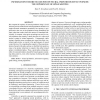Free Online Productivity Tools
i2Speak
i2Symbol
i2OCR
iTex2Img
iWeb2Print
iWeb2Shot
i2Type
iPdf2Split
iPdf2Merge
i2Bopomofo
i2Arabic
i2Style
i2Image
i2PDF
iLatex2Rtf
Sci2ools
ICASSP
2008
IEEE
2008
IEEE
Information theoretic bounds on neural prosthesis effectiveness: The importance of spike sorting
We compute the capacity of neural prostheses using a vector Poisson process model for the neural population channel. For single-electrode stimulation prostheses, the capacity is proportional to the size of the population being stimulated, the same value that results when each neuron is stimulated individually. In contrast, when gross recordings are used in control prostheses, the capacity is much less than it is when each neuron’s output is treated separately. Consequently, spike sorting, whereby gross recordings are sorted into their constituent spike trains, is crucial to the performance of neural control devices. By computing the capacity of the neural population channel with spike sorting, we find that false positives cause a far greater reduction in capacity than either missed spikes or mislabeled spikes. Thus, a good spike sorting algorithm for neural prostheses should be biased against committing false positives, even at the expense of altering the spike train statistics.
| Added | 30 May 2010 |
| Updated | 30 May 2010 |
| Type | Conference |
| Year | 2008 |
| Where | ICASSP |
| Authors | Ilan N. Goodman, Don H. Johnson |
Comments (0)

